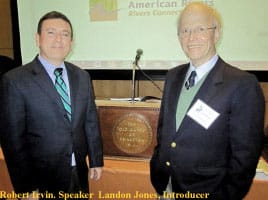February 29, 2012
Rivers Connect Us: Protecting and Restoring Our Nation’s Rivers
Robert Irvin
President & CEO, American Rivers
Rivers Connect Us: Protecting and Restoring Our Nation’s Rivers
Robert Irvin
President & CEO, American Rivers
Minutes of the 22nd Meeting of the 70th Year
The ninety-one members present at the twenty-second meeting of the seventieth year of the Old Guard of Princeton were called to order by President Robert Varrin at 10:15 am. He commented that this is the first time since 1984 that the Old Guard has met on February 29th.
Tom Fulmer led the invocation and Owen Leach read his minutes of the February 22, 2011 meeting. Jack Reilly introduced his guest and prospective member Dick Eiger. Landon Jones introduced his guests Jim Waltman, Executive Director at Stony Brook-Millstone Watershed Association and Geoff Goll, Princeton Hydro. Both guests are friends of the speaker.
Landon Jones introduced Robert Irvin, President and CEO of American Rivers as the nation’s leading advocate for our rivers. Before he joined American Rivers last year, he was Senior Vice President for Conservation Programs at Defenders of Wildlife. He has also worked with the World Wildlife Fund and the Center for Marine Conservation. He has served as Majority Counsel for Fish & Wildlife on the U.S. Senate Committee on Environment and Public Works. Mr. Irvin graduated magna cum laude with a BS in Forest Science from Utah State University in 1980 and earned a law degree from the University of Oregon in 1983.
As an introduction to his talk, Mr. Irvin recounted a time in his childhood when he was on a cross-country trip with his family and saw the Glen Canyon Dam under construction. Only later did he realize that he was among the last persons to see Glen Canyon before it became Lake Powell.
American Rivers was founded in 1973 by a group of environmentalists as part of the great environmental awaking after Earth Day and the signing of the Clean Water Act a year earlier. Initially American Rivers was one man at a desk in Washington, D.C. Still headquartered in Washington, it has expanded to nine regional offices and additional field offices across the country
Our speaker reminded us of the importance and extent of rivers in our history, geography, health and recreation. Rivers served as our first highways and were of strategic importance in the wars fought on our soil. The Mississippi Basin alone includes all or part of 31 of the lower 48 states. Two-thirds of our drinking water comes from rivers. Recreational fishing contributes $188 billion dollars to the economy. Yet, forty years ago rivers were also places to dump sewage and toxic waste and famously to catch fire in Cleveland.
Mr. Irvin said the one thing that excites him about leading American Rivers is that he’s in a ‘sweet spot’ because his issue matters to everyone: we all need water. A recent Gallup poll revealed that a supply of fresh water and stopping water pollution were top environmental issues. One major problem that continues is that sanitary sewer systems aren’t equipped to handle runoff after a major storm and the overflow ends up in a nearby river. In addition, climate change contributes both to drought when it doesn’t rain and extensive flooding when it does. Most water systems in the US are over 100 years old and our infrastructure is in need of major repair.
So what work does American Rivers actually do?
Clean water:
Respectfully submitted,
Jock McFarlane
(An abbreviated version of these minutes was read at the meeting on March 7, 2012)
Tom Fulmer led the invocation and Owen Leach read his minutes of the February 22, 2011 meeting. Jack Reilly introduced his guest and prospective member Dick Eiger. Landon Jones introduced his guests Jim Waltman, Executive Director at Stony Brook-Millstone Watershed Association and Geoff Goll, Princeton Hydro. Both guests are friends of the speaker.
Landon Jones introduced Robert Irvin, President and CEO of American Rivers as the nation’s leading advocate for our rivers. Before he joined American Rivers last year, he was Senior Vice President for Conservation Programs at Defenders of Wildlife. He has also worked with the World Wildlife Fund and the Center for Marine Conservation. He has served as Majority Counsel for Fish & Wildlife on the U.S. Senate Committee on Environment and Public Works. Mr. Irvin graduated magna cum laude with a BS in Forest Science from Utah State University in 1980 and earned a law degree from the University of Oregon in 1983.
As an introduction to his talk, Mr. Irvin recounted a time in his childhood when he was on a cross-country trip with his family and saw the Glen Canyon Dam under construction. Only later did he realize that he was among the last persons to see Glen Canyon before it became Lake Powell.
American Rivers was founded in 1973 by a group of environmentalists as part of the great environmental awaking after Earth Day and the signing of the Clean Water Act a year earlier. Initially American Rivers was one man at a desk in Washington, D.C. Still headquartered in Washington, it has expanded to nine regional offices and additional field offices across the country
Our speaker reminded us of the importance and extent of rivers in our history, geography, health and recreation. Rivers served as our first highways and were of strategic importance in the wars fought on our soil. The Mississippi Basin alone includes all or part of 31 of the lower 48 states. Two-thirds of our drinking water comes from rivers. Recreational fishing contributes $188 billion dollars to the economy. Yet, forty years ago rivers were also places to dump sewage and toxic waste and famously to catch fire in Cleveland.
Mr. Irvin said the one thing that excites him about leading American Rivers is that he’s in a ‘sweet spot’ because his issue matters to everyone: we all need water. A recent Gallup poll revealed that a supply of fresh water and stopping water pollution were top environmental issues. One major problem that continues is that sanitary sewer systems aren’t equipped to handle runoff after a major storm and the overflow ends up in a nearby river. In addition, climate change contributes both to drought when it doesn’t rain and extensive flooding when it does. Most water systems in the US are over 100 years old and our infrastructure is in need of major repair.
So what work does American Rivers actually do?
Clean water:
- American Rivers works at a national policy level to be sure the Clean Water Act remains a strong and effective law. After 40 years of success in showing results in cleaner rivers, the Act is threatened by efforts to limit protection of headwaters and adjacent areas of rivers & streams. Legislation already passed by the House would limit EPA authority over plans approved by the Corps of Engineers.
- Green infrastructure work – green roofs, green gardens, and permeable pavement to reduce and filter runoff before it enters a river. Working with cities to replace hard infrastructure with a green alternative.
- Use ‘hidden reservoirs’ of water such as using gray water and focusing on effective conservation instead of building new hard reservoirs.
- The Wild and Scenic River Protection Act of 1968 allows the Federal Government to designate wild and scenic rivers that enjoy special protection from development. New Jersey is a leader in protecting wild and scenic and has five rivers with that designation. American Rivers collaborated in an effort to remove a dam on the lower part of the Musconetcong River, one of New Jersey’s designated rivers. A current project is to remove the Blackwell’s Mill dam on the Millstone River.
- Establish “Blue Trails” which are water trails on rivers for canoeing and fishing with protection for adjacent land.
- Remove old and outdated dams that have outlived their usefulness. This does not mean that American Rivers is opposed to all dams. They have served and continue to serve useful purposes in providing hydropower and recreation areas. Other dams need to be updated.
- The largest dam removal program in the US began last fall with the first steps in removing two dams on the Elwha River in Washington State. This was accomplished after years of negotiations and appropriations. Mr. Irvin showed a video of the initial explosion at the base of the first dam that released a spectacular gusher of water from the bottom of the reservoir behind the dam. When the removal is completed salmon will be able to swim upstream to spawning grounds they haven’t been able to visit for a hundred years.
- American Rivers unilaterally declared 2011 “The Year of the River” to mark the fact that 1,000 dams have been removed in the past 100 years.
Respectfully submitted,
Jock McFarlane
(An abbreviated version of these minutes was read at the meeting on March 7, 2012)

